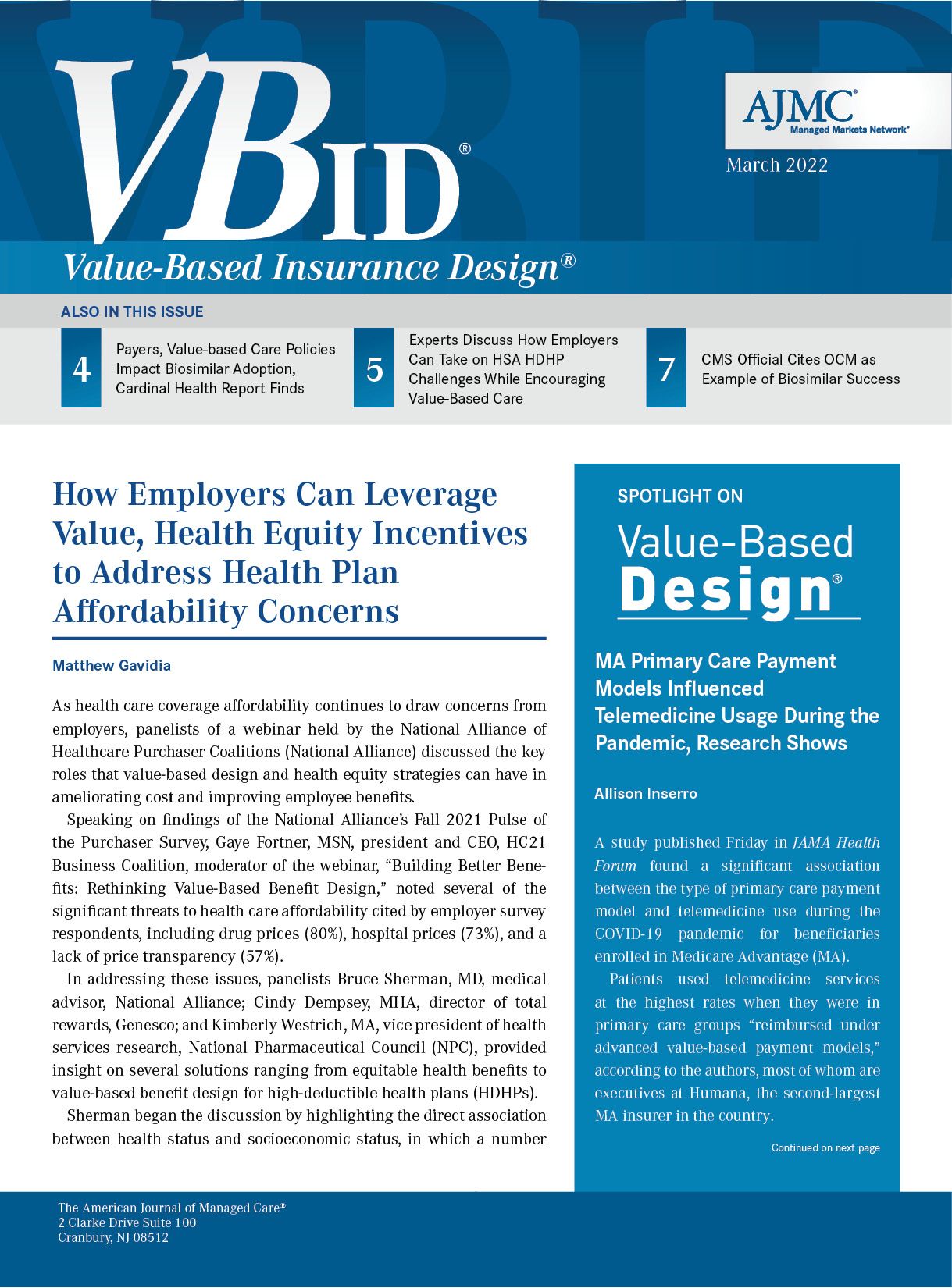Publication
Article
VBID® Value-Based Insurance Design® Newsletter
How Employers Can Leverage Value, Health Equity Incentives to Address Health Plan Affordability Concerns
Author(s):
Part 1 of a 2-part webinar series by the National Alliance of Healthcare Purchaser Coalitions addressed issues in health care coverage affordability and how equitable health benefits and value-based design can reduce cost while improving employee engagement.
As health care coverage affordability continues to draw concerns from employers, panelists of a webinar held by the National Alliance of Healthcare Purchaser Coalitions (National Alliance) discussed the key roles that value-based design and health equity strategies can have in ameliorating cost and improving employee benefits.
Speaking on findings of the National Alliance’s Fall 2021 Pulse of the Purchaser Survey, Gaye Fortner, MSN, president and CEO, HC21 Business Coalition, moderator of the webinar, "Building Better Benefits: Rethinking Value-Based Benefit Design," noted several of the significant threats to health care affordability cited by employer survey respondents, including drug prices (80%), hospital prices (73%), and a lack of price transparency (57%).
In addressing these issues, panelists Bruce Sherman, MD, medical advisor, National Alliance; Cindy Dempsey, MHA, director of total rewards, Genesco; and Kimberly Westrich, MA, vice president of health services research, National Pharmaceutical Council (NPC), provided insight on several solutions ranging from equitable health benefits to value-based benefit design for high-deductible health plans (HDHPs).
Sherman began the discussion by highlighting the direct association between health status and socioeconomic status, in which a number of chronic diseases, such as diabetes and hypertension, are inversely associated with income.
“What is particularly concerning for low-wage workers is that in addition to having the highest prevalence of unhealthy lifestyle behaviors, they also have a significant financial burden in that they are the group with the highest proportion of health care costs as a percentage of their wages,” said Sherman. “Not only are they paying out more because they have a greater prevalence of disease, but they're also earning less.”
Adding in health literacy concerns that may contribute to the increased use of high intensity resources, namely hospitalizations or emergency department visits, as well as a lower adherence to preventive care services, the gap in quality of care between low- and high-income workers has also spotlighted race as a major factor.
Sherman noted that when assessing specialty drug use by employees with an autoimmune disorder, findings indicated that as income drops, an increasing gap was shown between the proportion of White individuals taking specialty medications vs those identified as Black and Hispanic.
“We have issues of implicit bias, we have issues of culturally sensitive and appropriate care, we have issues in medical mistrust. These can't necessarily be addressed by benefit design, per se, but employers certainly can take steps to help to address these—there are things that employers can do from a plan design standpoint,” he said.
Citing benefits equity as a notable strategy, Sherman said that currently 93% of employers have plan designs with employee cost irrespective of their income for different plan options.
In promoting greater equity from the standpoint of employer subsidies for benefit design, he added that employers should consider the growing research on associations of race and income as influencing factors of health benefit utilization and cost.
“Understanding that data can provide a roadmap for directed and strategic interventions to better support the health and well-being of their benefits enrollees,” Sherman said.
Panelist Cindy Dempsey next provided an example of how her organization, Genesco, a fashion retailer with over 13,000 employees in the United States and Canada, worked to incentivize value in its benefit design to ensure equity and engagement.
With a majority of its workforce being part time and of a younger demographic (average age, 31 years), she noted that the health plan that was in place when she started 5 years ago was geared toward moderate utilizers with moderate income, and had a myriad of difficult-to-understand penalties and surcharges. Less than half (47%) of eligible employees enrolled in benefits, and of those enrolled, 69% had employee-only coverage.
“When we looked at what our members actually paid in claims to participate in the health plan, a huge spike was observed in the people who paid less than $500 into the plan in co-pays and coinsurance and deductibles,” said Dempsey.
“So, even the people who utilized the plan for the most part never reached the deductible—what that means is that there were all these employees paying just about $2000 a year for medical coverage, which was basically around 7% of their income, and most of them got zero value out of the plan.”
As this helped explain why a majority of employees were not enrolled in health benefits, Dempsey implemented several redesign objectives based on employee feedback:
- Choice: offer a choice of plans that better meets the needs of diverse employee population
- Difference: offer plans with meaningfully different actuarial values
- Company cost: company remains agnostic to plan choice
- Employee cost: reduce the cost of access, expand covered preventive services, and reduce/eliminate penalties
- Value: improve the value of the benefit
In offering plans personalized by lower income/lower utilization, higher income/high value, and a mid-value option, continuous migration in enrollment was noted since the first year the plans were offered, with employees choosing the plan that best fit their needs.
“We have continued to expand our preventive drug list.…We are continually asking our carrier and our partner vendor partners to find ways to put necessary medications in front of the deductibles and reduce the cost share, and then we've reduced or eliminated altogether, the cost of telemedicine,” added Dempsey.
Kimberly Westrich lastly provided a sneak peek of the content to be discussed in the second part of the webinar series to be held on February 15, 2022, in which she will be serving as moderator.
With one-third of all covered workers enrolled in HDHPs as of 2021, health savings account (HSA)–eligible plans have emerged as the predominant model of these health plans.
The upcoming webinar will address 3 different publications that all have action steps for employers who seek to design their HDHPs to incentivize greater value, including action briefs released by NPC with the National Alliance, Paul Fronstin, MD, from the Employee Benefit Research Institute, and A. Mark Fendrick, MD, from the Center for Value-Based Insurance Design, and one to be released on February 14, 2022, on best practices.

Newsletter
Stay ahead of policy, cost, and value—subscribe to AJMC for expert insights at the intersection of clinical care and health economics.




